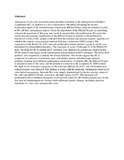Genetic alterations of the retinoblastoma-related gene RB2/p130 identify different pathogenetic mechanisms in and among Burkitt's lymphoma subtypes.

View/
Date
2000-03Author
Cinti, C;
Leoncini, L;
Nyongo, A
Ferrari, F;
Lazzi, S;
Bellan, C;
Vatti, R;
Zamparelli, A;
Cevenini, G;
Tosi, GM
Type
ArticleLanguage
enMetadata
Show full item recordAbstract
Alterations of cell cycle-associated genes probably contribute to the pathogenesis of Burkitt's Lymphoma (BL), in addition to c-myc translocation. Mutations disrupting the nuclear localization signal of the retinoblastoma-related gene RB2/p130 have been documented recently in BL cell lines and primary tumors. Given the importance of the RB2/p130 gene in controlling cell growth, mutations of this gene may result in uncontrolled cell proliferation. We tested the expression and genomic organization of the RB2/p130 gene in relation to the proliferative features of a series of BL samples collected from the endemic and sporadic regions, regardless of whether the samples were acquired immune deficiency syndrome (AIDS)-related. The expression of the Rb2/p130, p107, and cell proliferation-related proteins (cyclin A and B) was determined by immunohistochemistry. The structures of exons 19 through 22 of the RB2/p130 gene, encoding for the B domain and C terminus, were analyzed by polymerase chain reaction (PCR) analysis and single-strand conformation polymorphism (SSCP) technique. The direct PCR products were sequenced to identify the actual mutations. Our results suggest that BL is composed of a mixture of molecular types with distinct genetic and phenotypic patterns, probably resulting from different pathogenetic mechanisms. In endemic BL, the RB2/p130 gene is mutated in most of the cases, and the protein is restricted to the cytoplasm. In AIDS-related BL, high levels of nuclear expression of the wild-type pRb2/p130, p107, and cell proliferation-related proteins were detected. This finding is in line with the molecular mechanisms observed in virus-linked oncogenesis. Sporadic BLs were mainly characterized by the low nuclear values of the wild-type pRb2/p130 and, conversely, the high values of p107. The increased cell proliferation due to different alterations of cell growth control by Rb-related proteins may be the first step in lymphomagenesis, during which additional genetic changes, including missense mutations of c-myc, may subsequently occur.
URI
http://www.ncbi.nlm.nih.gov/pubmed/10702389http://erepository.uonbi.ac.ke:8080/xmlui/handle/123456789/30551
Citation
Am J Pathol. 2000 Mar;156(3):751-60.Publisher
University of Nairobi, Institute of Normal and Pathologic Cytomorphology, Consiglio Nazionale delle Ricerche, Bologna, Italy. Department of Human Pathology, College of Health Sciences, University of Nairobi, Kenya
Collections
- Faculty of Health Sciences (FHS) [10378]
